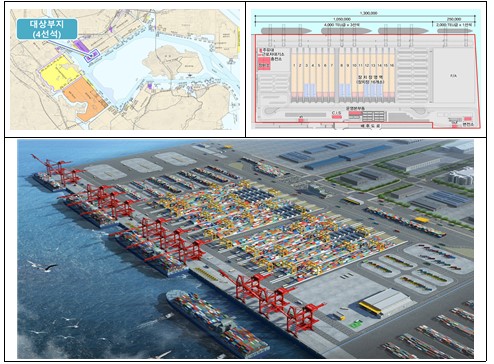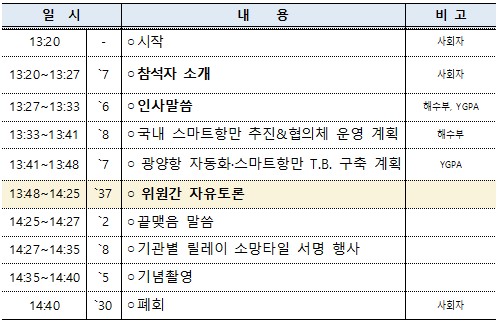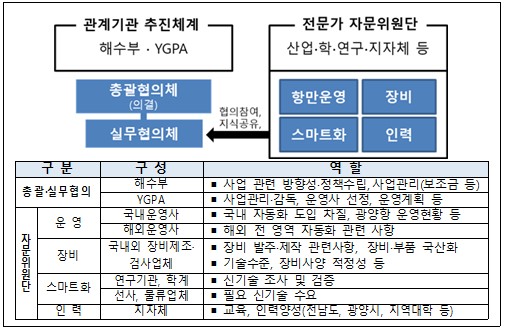– Full-scale start of port automation test bed construction project in Gwangyang Port (6.29.(Wed)) –
The Ministry of Oceans and Fisheries held the 'Gwangyang Port Automation Test Bed Launch Report Contest' at the World Marine Center located in Gwangyang Port on June 6th (Wednesday) and announced that the 'Gwangyang Port Automation Test Bed Construction Project' would begin in earnest.
Major ports around the world are using 4th industrial revolution technologies such as artificial intelligence (AI) and Internet of Things (IoT) with the goal of securing efficiency and stability of cargo handling. (Full-Automated Port)' has been built and operated, and smartization is being promoted based on this recently.
* 6 ports including Rotterdam Port in the Netherlands, Shanghai Port in China, Long Beach Port in the United States, and TUAS Port in Singapore
The Ministry of Oceans and Fisheries has also been promoting the establishment of a port automation-based test bed in Gwangyang Port to stably build a smart port, secure our technology related to smart ports, and strengthen industrial competitiveness. Since the establishment of the 2020 implementation plan, it has passed the preliminary feasibility study in November last year, and the full-fledged start of the project will be held with the opening report meeting on June 6 (Wednesday).
A total of KRW 3 billion was invested from 2 to 4 in the 2022 berths of the Gwangyang Port Phase 2026-6,915 container pier, 11 automated quay cranes (C/C, Container Crane), and automatic transfer equipment (L-AGV, Lift-Automated Guided Vehicle) Automated loading and unloading equipment, including 44 units and 32 Automated Rail Mounted Gantry Cranes (ARMGC), will be introduced mainly with domestic technology.
At the same time, infrastructure such as operational buildings, packaging, and communication will be built together, and the new technology test and verification area (area 9 mXNUMX) can be verified in connection with automated ports and related new technologies and equipment developed through R&D. )' is also built. Through this, various smart technologies can be applied and verified throughout the entire port logistics process, and when operational data is secured, domestic companies will be able to participate in smart port construction, which is expected to lay the foundation for the domestic industry.
To facilitate the project, the Ministry of Oceans and Fisheries and the project operator, Yeosu Gwangyang Port Authority (YGPA) will form and operate a consultative body, and plan to operate an 'Expert Advisory Committee' composed of industry, academia, and research experts. to be.
Kim Chang-gyun, Director of Port Department of Oceans and Fisheries said, “Amid the global logistics crisis, automation and smart ports are essential to secure domestic port competitiveness. We will do our best to successfully build the Gwangyang Port test bed and to quickly implement a smart port in Korea.”
Note 1
Gwangyang Port Port Automation Test Bed Construction Project Overview
□ Business goals
ㅇ Establishment of 「Port Automation Test Bed」 in Gwangyang Port to introduce stable automated port* and secure competitiveness of Gwangyang Port 'Kern' Pier
* Establishment of a port automation test bed centered on domestic technology to minimize trial and error for other domestic ports and to secure the performance and experience of domestic companies
– Promoting the stable construction of domestic automated ports such as Jinhae New Port by utilizing the experience results of this project and domestic companies entering the global market
ㅇ Improvement of productivity and operational efficiency of Gwangyang Port container wharf according to the first automated port in all areas in Korea
< Gwangyang Port Port Automation Test Bed Introduction Strategy Conceptual Map >

□ Highlights
ㅇ Establish and operate a business promotion system* to achieve the business purpose ('22.6~)
* Ministry of Oceans and Fisheries, Yeosu Gwangyang Port Authority, local government, operator, research institute, etc.
ㅇ Started test bed construction work and port automation equipment introduction ('23.~)
ㅇ Test bed construction completed ('25.), pilot operation ('26.), opening ('27.)
□ Business Overview
ㅇ (Location/Scale) Gwangyang Port Phase 3-2 Container Pier / 4 berths
ㅇ (total project cost/period) KRW 6,915 billion (50% from the government, 50% from Yeosu Gwangyang Port Authority) / '22~'26
ㅇ (Main equipment) Remote quay crane (11 units), Lift-AGV (44 units), ARMGC (32 units), etc.
* (Lot site site) Site area of 750,000㎡ / (Upper functional facility) Automation equipment (16 blocks), water and sewerage, electricity and communication facilities, etc.
□ Business location and bird's eye view

□ Expected effect
ㅇ It is also expected to improve productivity (about 30%) and operational efficiency, reduce pollutants by 84% (diesel → electric power source conversion) per TEU, and reduce safety accidents by 90% due to port automation
Note 2
Gwangyang Port Port Automation Test Bed Initiation Reporting Competition Event Plan
□ Event Overview
ㅇ (Purpose) To formalize the full-scale promotion of the port automation test bed project in Gwangyang Port, to launch a consultative body and hold a report on related services*
* After the main event, the service commencement report meeting will be held separately
ㅇ (Date/Venue) '22.6.29 (Wed) 13:20~14:40/World Marine Center International Conference Hall (2nd floor)
ㅇ (Participant) Ministry of Oceans and Fisheries (manager of port, etc.), YGPA (president, etc.), local government, private expert

□ Detailed schedule

Note 3
Gwangyang Port Port Automation Test Bed Promotion Council Composition Plan
□ Composition background
ㅇ Establish a communication system with related organizations and consultations with related organizations, taking into account the seamless project promotion to secure port automation technology and the nature of the convergence business (equipment/operation S/W, etc.)
□ Composition/operation plan
ㅇ (Composition) A general consultative body among related agencies is formed for consultation and decision-making on major matters*;
* Facility/equipment plan, smart technology introduction and application, new technology utilization plan, etc.
– Formation of an advisory committee of 4 people in 39 fields to identify advisory and trends in specialized fields, and formation and operation of a working group for consultation and decision-making
* Participation in discussion on issues related to the local community, such as contribution to the local community, human resource training, and existing worker issues
ㅇ (Operation) In principle, the general consultative body meets once every semi-annually and the working-level council meets once a quarter, but it is operated flexibly according to the situation of the agenda.
– The advisory committee operates flexibly, including participation in working-level consultations and face-to-face and non-face-to-face (written) advice.
< Gwangyang Port Port Automation Test Bed Promotion System Structure >




